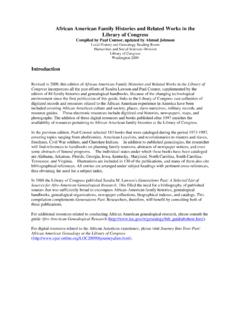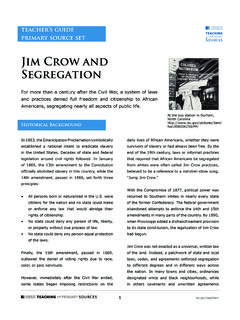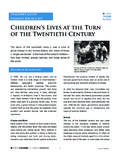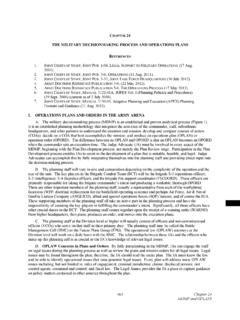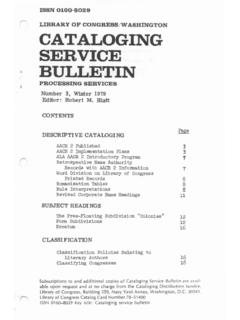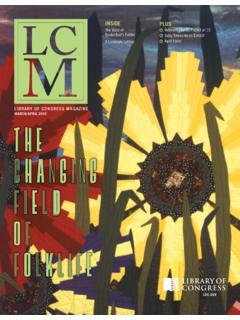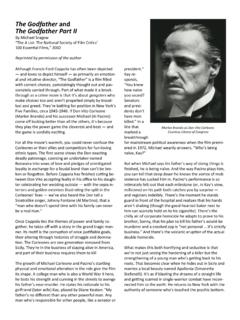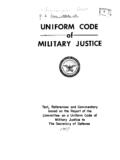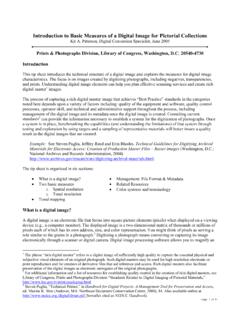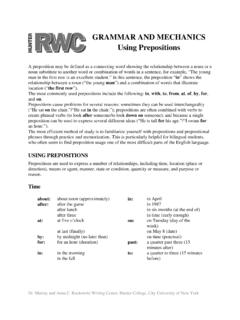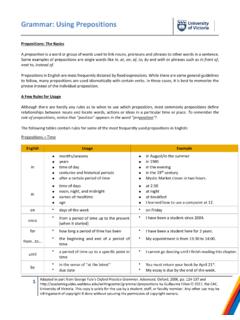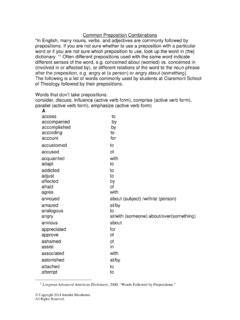Transcription of Arabic romanization table - Library of Congress
1 Arabic Letters of the Alphabet Initial Medial Final Alone romanization omit (see Note 1) b t th j kh d dh r z s sh (ayn) gh f (see Note 2) q (see Note 2) k l m n h (see Note 3) w y Vowels and Diphthongs a (see Rule 5) u (see Rule 6(a)) aw i ay Letters Representing Non- Arabic Consonants This list is not exhaustive.
2 It should be noted that a letter in this group may have more than one phonetic value, depending on the country or area where it is used, and that the romanization will vary accordingly. g ch v zh v p zh v Notes 1. For the use of alif to support hamzah, see rule 2. For the romanization of hamzah by the consonantal sign (alif), see rule 8(a). For other orthographic uses of alif see rules 3-5. 2. The Maghrib variations and are romanized f and q respectively. 3. in a word in the construct state is romanized t. See rule 7(b). RULES OF APPLICATION Arabic Letters Romanized in Different Ways Depending on Their Context 1.
3 As indicated in the table , and may represent: (a) The consonants romanized w and y, respectively. wa iwa dalw yad iyal ahy (b) The long vowels romanized , , and respectively. l rah dh m n j l f kit b sa b jum n See also rules 11(a) and 11(b)(1-2). (c) The diphthongs romanized aw and ay, respectively. awj nawm law aysar shaykh aynay See also rules 11(a)(2) and 11(b)(3).
4 2. (alif), and when used to support (hamzah) are not represented in romanization . See rule 8(a). 3. (alif) when used to support wa lah ( ) and maddah ( ) is not represented in romanization . See rules 9 and 10. 4. (alif) and when used as orthographic signs without phonetic significance are not represented in romanization . fa al ul ika q yah See also rule 12 and examples cited in rules 23-26. 5. (alif) is used to represent the long vowel romanized , as indicated in the table . f il ri This alif, when medial, is sometimes omitted in Arabic ; it is always indicated in romanization .
5 See rule 19. 6. Final appears in the following special cases: (a) As (alif maq rah) used in place of to represent the long vowel romanized . att ma kubr Ya y musamm Mu af (b) As in nouns and adjectives of the form f l which are derived from defective roots. This ending is romanized , not y, without regard to the presence of (shaddah). See rule 11(b)(2). Ra al-D n Compare the fa l form of the same root [without shaddah] al-Ra . (c) As in the relative adjective (nisbah).
6 The ending, like (b) above, is romanized , not y. al-Mi r Compare al-Mi r yah and see rule 11(b)(1). 7. (t marb ah) (a) When the noun or adjective ending in is indefinite, or is preceded by the definite article, is romanized h. The in such positions is often replaced by . al h al-Ris lah al-bah yah mir h Urj zah f al- ibb (b) When the word ending in is in the construct state [mu f wa-mu f ilayh], is romanized t. Wiz rat al-Tarbiyah Mir t al-zam n (c) When the word ending in is used adverbially, (vocalized ) is romanized tan.
7 See rule 12(b). romanization of Arabic Orthographic Symbols Other than Letters and Vowel Signs The signs listed below are frequently omitted from unvocalized Arabic writing and printing; their presence or absence must then be inferred. They are represented in romanization according to the following rules: 8. (hamzah) (a) In initial position, whether at the beginning of a word, following a prefixed preposition or conjunction, or following the definite article, is not represented in romanization . When medial or final, is romanized as (alif). asad uns idh mas alah mu tamar d im mala a kha i a (b) , when replaced by the sign (wa lah) and then known as hamzat al-wa l, is not represented in romanization .
8 See rule 9 below. 9. (wa lah), like initial , is not represented in romanization . See also rule 8(b) above. When the alif which supports wa lah belongs to the article , the initial vowel of the article is romanized a. See rule 17(b). In other words, beginning with hamzat al-wa l, the initial vowel is romanized i. Ri lat Ibn Jubayr al-istidr k kutub iqtanat h bi-ihtim m Abd al-Maj d 10. (maddah) (a) Initial is romanized . lah Kull yat al- d b (b) Medial , when it represents the phonetic combination , is so romanized.
9 Ta l f ma thir (c) is otherwise not represented in romanization . khulaf 11. (shaddah or tashd d) (a) Over : (1) , representing the combination of long vowel plus consonant, is romanized w. ad w q wah See also rule 1(b). (2) , representing the combination of diphthong plus consonant, is romanized aww. Shaww l awwara jaww See also rule 1(c). (b) Over : (1) Medial , representing the combination of long vowel plus consonant, is romanized y. al-Mi r yah See also rule 1(b).
10 (2) Final is romanized . See rules 6(b) and 6(c). (3) Medial and final , representing the combination of diphthong plus consonant, is romanized ayy. ayy m sayyid Qu ayy See also rule 1(c). (c) Over other letters, is represented in romanization by doubling the letter or digraph concerned. al-Ghazz al-Kashsh f 12. Tanw n may take the written form , ( ), or , romanized un, an, and in, respectively. Tanw n is normally disregarded in romanization , however. It is indicated in the following cases: (a) When it occurs in indefinite nouns derived from defective roots.
